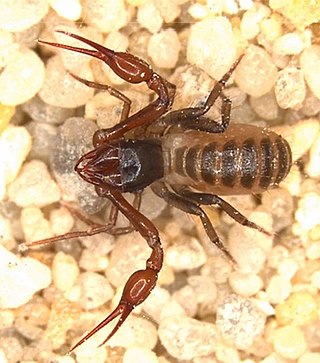
Pseudoscorpions, also known as false scorpions or book scorpions, are small, scorpion-like arachnids belonging to the order Pseudoscorpiones, also known as Pseudoscorpionida or Chelonethida.

Chthoniidae is a family of pseudoscorpions within the superfamily Chthonioidea. The family contains more than 600 species in about 30 genera. Fossil species are known from Baltic, Dominican, and Burmese amber. Chthoniidae now includes the former families Tridenchthoniidae, and Lechytiidae which has been demoted to subfamilies.
Phagophilia or phagophily is feeding on parasites.
Anaulacodithella is a genus of pseudoscorpions in the family Tridenchthoniidae. There are about seven described species in Anaulacodithella.
Compsaditha is a genus of pseudoscorpions in the family Tridenchthoniidae. There are about 12 described species in Compsaditha.
Max Beier was an Austrian arachnologist and entomologist.
Garypus titanius, the giant pseudoscorpion is a Critically Endangered species of pseudoscorpion that is endemic to Boatswain Bird Island, a small rocky island off Ascension Island in the South Atlantic Ocean.

The Chernetidae are a family of pseudoscorpions with over 650 described species and 110 genera.
Atemnidae is a family of pseudoscorpions.
Synsphyronus is a genus of pseudoscorpions in the family Garypidae, which has been found in Australia, New Zealand and New Caledonia.
Hesperochernes is a genus of pseudoscorpions in the family of Chernetidae.

Pseudotyrannochthoniidae is a family of pseudoscorpions, belonging to the superfamily Chthonioidea. It represents the most basal and primitive group of living pseudoscorpions, containing 50 species in 5 genera. Living members of the group have a strongly disjunct distribution, likely reflecting ancient vicariance, occurring in Australia, Asia, Southern Africa and Madagascar, Western North America and southern South America. Fossils species are known from the Eocene Baltic and Bitterfeld amber, which represent members of extant Asian genera.
Austrochernes is a genus of pseudoscorpions in the subfamily Chernetinae, first described by Max Beier in 1932. The Australian Faunal Directory decisions for synonymy are based on a 2018 paper by Mark Harvey.
Austrochthonius cavicola is a species of pseudoscorpion in the Chthoniidae family. It is endemic to Australia. It was described in 1968 by Austrian arachnologist Max Beier.
Lagynochthonius mordor is a species of pseudoscorpion in the Chthoniidae family. It is endemic to Australia. It was described in 1989 by Australian arachnologist Mark Harvey. The specific epithet mordor refers to the type locality.
Tyrannochthonius cavernicola is a species of pseudoscorpion in the Chthoniidae family. It is endemic to Australia. It was described in 1976 by Austrian arachnologist Max Beier.
Tyrannochthonius norfolkensis is a species of pseudoscorpion in the Chthoniidae family. It was described in 1976 by Austrian arachnologist Max Beier.
Tyrannochthonius kermadecensis is a species of pseudoscorpion in the Chthoniidae family. It was described in 1976 by Austrian arachnologist Max Beier.
Sathrochthonius insulanus is a species of pseudoscorpion in the Chthoniidae family. It is endemic to Australia. It was described in 1976 by Austrian arachnologist Max Beier.



